1992 Paralympic Games - Barcelona
Tadhg Slattery
With the return of South African athelete to international competition, the country won only one medal in the swimming - Tadhg Slattery in the 100 m breaststroke SB5.
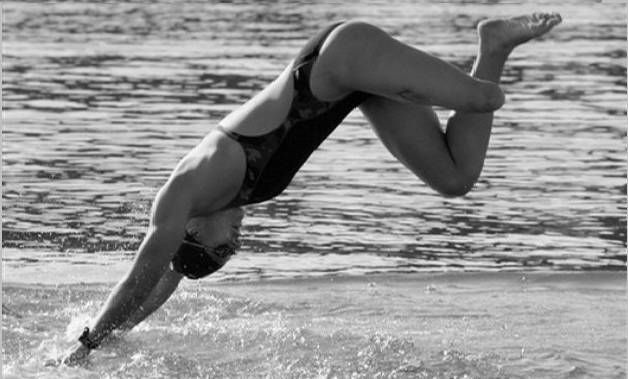
The most notable disabled swimming champion in South Africa is probably Natalie du Toit (above). At the 2008 Beijing Olympic Games, Natalie proved that disabled swimming was part of the sport of competitive swimming at the highest level when she competed against able-bodied swimmers in the Olympic 10km open water marathon event. Natalie won 13 Paralympic gold medals (2004 - 2012).
The Paralympian story started many years before Natalie's successes. Disabled swimmers from South Africa have set numerous world records, but the early (pre-1992) history of paraplegic/disabled sports in South Africa is largely unknown to the public today (2024) although some newspaper archives contain published results of paraplegic/paralympic sports. Even the results from the International Stoke Mandeville Games (1948-59) do not seem to exist.
The history of disabled swimming in South Africa must also acknowledge the work done by coaches and swimming clubs. The early champions seem to have developed at the Elizabeth Conradie School in Kimberley and the Hope School in Johannesburg, where Tadhg Slattery is a coach.
A detailed set of South African medal results is listed at the end of this page.
One of the earliest para swimmers from South Africa was probably Neville Cohen. In 1956 Neville Cohen won the breaststroke final at the Stoke Mandeville Games. Read more about Neville here...
In November 1964 South Africa sent a team to the 1964 Paralympic Games. Paradoxically, South Africa began to compete at the Paralympics after being barred from participating in the Tokyo Olympic Games in 1964.
Gordon Popperwell (Western Province) won a silver medal in breaststroke, while in the women's events, A. Somerset won a gold and two silver medals and N. Thesen won a bronze medal. Rhodesians Lynette Gilchrist and Leslie Manson-Bishop won 6 medals of which 5 were gold.
Willie Nel broke two world records at the 1968 South African Paraplegic Championships in Kimberley and then won a gold medal at the 1968 Paralympic Games held in Tel Aviv. David Lewis, a pupil at the Elizabeth Conradie School in Kimberley, also swam in these Paralympic Games, winning two medals.
Despite setting two world records at the Games in Kimberley, Riana van der Schyff did not get to swim at the 1968 Paralympic Games. At the SA Paraplegic Championships in 1969, Riana set three new world records!
The 1972 Paralympic Games, the fourth edition of the Paralympic Games, were held in Heidelberg, West Germany, from 2 to 11 August 1972, two weeks before the Summer Olympics were held in Munich. The outstanding athlete of these Games was Riana van der Schyff from South Africa who won four gold medals in swimming and two silver and a bronze medal in athletics field events (discus, javelin and shot put). Willie Bosch (1) and M. van der Riet (2) won gold in the men's swimming. South African swimmers, four male and five female, won a total of 18 medals - eight of which were gold. The Rhodesians won 9 medals - two gold - and Sandra James set a world record. She also won a gold medal in the Women's javelin throw.
Hester du Preez achieved set a world record at the 1978 South African Games in Bloemfontein.

1976 was the last time the Springbok Paralympians were allowed to compete at the Games, even though the Rhodesians were refused visas to enter Canada. M. Schaefer won bronze in women's backstroke while M. van der Riet (first name unknown) won two silver medals and a bronze with J. Crouse also winning a second-place silver medal.
The Netherlands, the host country of the 1980 Summer Paralympics, adopted a motion declaring South Africa's participation in the 1980 Games "undesirable". South Africa was subsequently absent from the Paralympic Games until 1992. The Rhodesians were allowed back to compete in 1980 - as Zimbabwe - winning 4 medals in swimming.
South Africa was subsequently absent from the Paralympic Games until 1992, at which point it also made its return to the Olympics, where Tadhg Slattery (below) won a gold medal in the 100m breaststroke in a world record time.
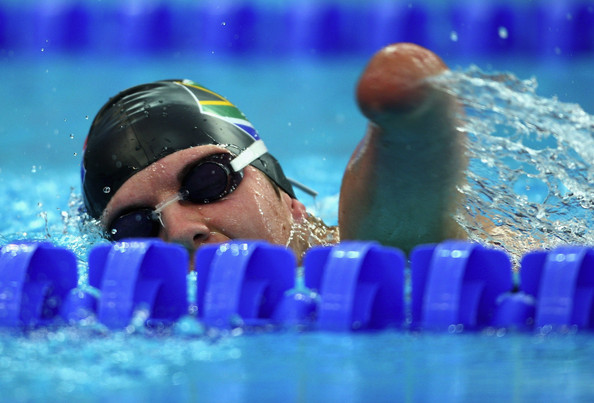
Since the re-admission of South African athletes to international competition in 1992 South African Paralympic swimmers have won ten Paralympic gold medals in men's swimming, with Ebert Kleynhans winning three in 1996 and 2000. Charl Bouwer (2008-2012)and Kevin Paul (2008-2016) have each won two gold medals.
The women's won fourteen first places - Natalie du Toit (2004-2012) took thirteen and Shireen Shapiro (2008-2012) one.
With the return of South African athelete to international competition, the country won only one medal in the swimming - Tadhg Slattery in the 100 m breaststroke SB5.
Terblanche won a gold medal at the 1994 IPC Swimming World Championships in Malta, at the age of 14, and in the 1996 Summer Paralympics in Atlanta winning a gold and bronze medal.
Ebert competed at three Paralympics winning three gold medals and one silver. His first games were in 1996 where he won the 50m freestyle in a new Games record.
- Director of Business Development at SaltyLama
- Founder of the online Fitness brand Coach Legs.
- 5 x World Championship Swimmer.
- 3 x Paralympic qualifier.
- Head coach for Zwartkop High School.
- Head coach for Hatfield Christian Primary and High School.
- Coach for Hennopspark Primary School.
- Tuks University Club Coach.
- Motivational Speaker at various events.
- 2017 Mens Health top 10 Cover Guy finalist.
Elizabeth competed in both the 1996 and 2000 Summer Paralympics. In 1996 she won a bronze medal in the 50m freestyle.
Craig competed in his first Paralympic games in 1996 where he won bronze in both the 50m freestyle and 100m freestyle.
He won silver in the 50m and 100m freestyle in 2000, and silver in the 100m freestyle and 400m freestyle in 2004.
At the 2008 Paralympics he won gold and set a new world record in the 400m freestyle.
In the 2012 London Paralympic Games he won the the 50m freestyle.
"I would never have dreamed a medal," he said after coming third to Paul Barnett of Australia and Maciej Maik of Poland. "I came to Sydney ranked 10th - then after my heat this morning I shot up to seventh.
Since his final Paralympic Games in 2016, Kevin has transitioned into a new phase of his career, focusing on creating, developing, and working with Sporting Academies in the region.
At the 2009 Maccabiah Games, Sapiro was appointed flag bearer for the South African delegation at the opening ceremony. While Sapiro generally competes in Paralympic events, she competed in the open competition of the swimming events against able-bodied swimmers.
South Africa's Olympic Committee chose Du Toit to carry their flag at the 2008 Summer Olympics opening ceremony, making her the first athlete to carry a flag in both the Olympics and Paralympics in a single year
“I feel that as a Paralympic Athlete, I have achieved more than I could possibly have dreamed of,” he said. “Paralympic sport and the Movement have given me so much to be grateful for.
At the 2012 London Paralympics Hendri made the finals for three of the events and won a bronze medal for the 100m freestyle; “dit was ‘n belewenis.”
Swanepoel was abruptly reclassified to swim against people with more physical function than she has, forcing her to learn a new stroke, and rethink her entire strategy.
2018 and 2022 Commonwealth Games, winning 1 silver medals in 2018 and a bronze medal in 2022.
Swam in 3 World Para Swimming Championships - winning 4 silver medals in 2017 and 2022.
Damon Kendrick lost a leg due to a shark attack, yet he still represented Western Province as a provincial-level diver in the 1970s and still does open water swimming races in 2024.
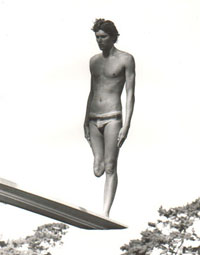
In March 1977 Coreen Swanepoel of Stellenbosch was the first paraplegic swimmer to achieve a Robben Island crossing.

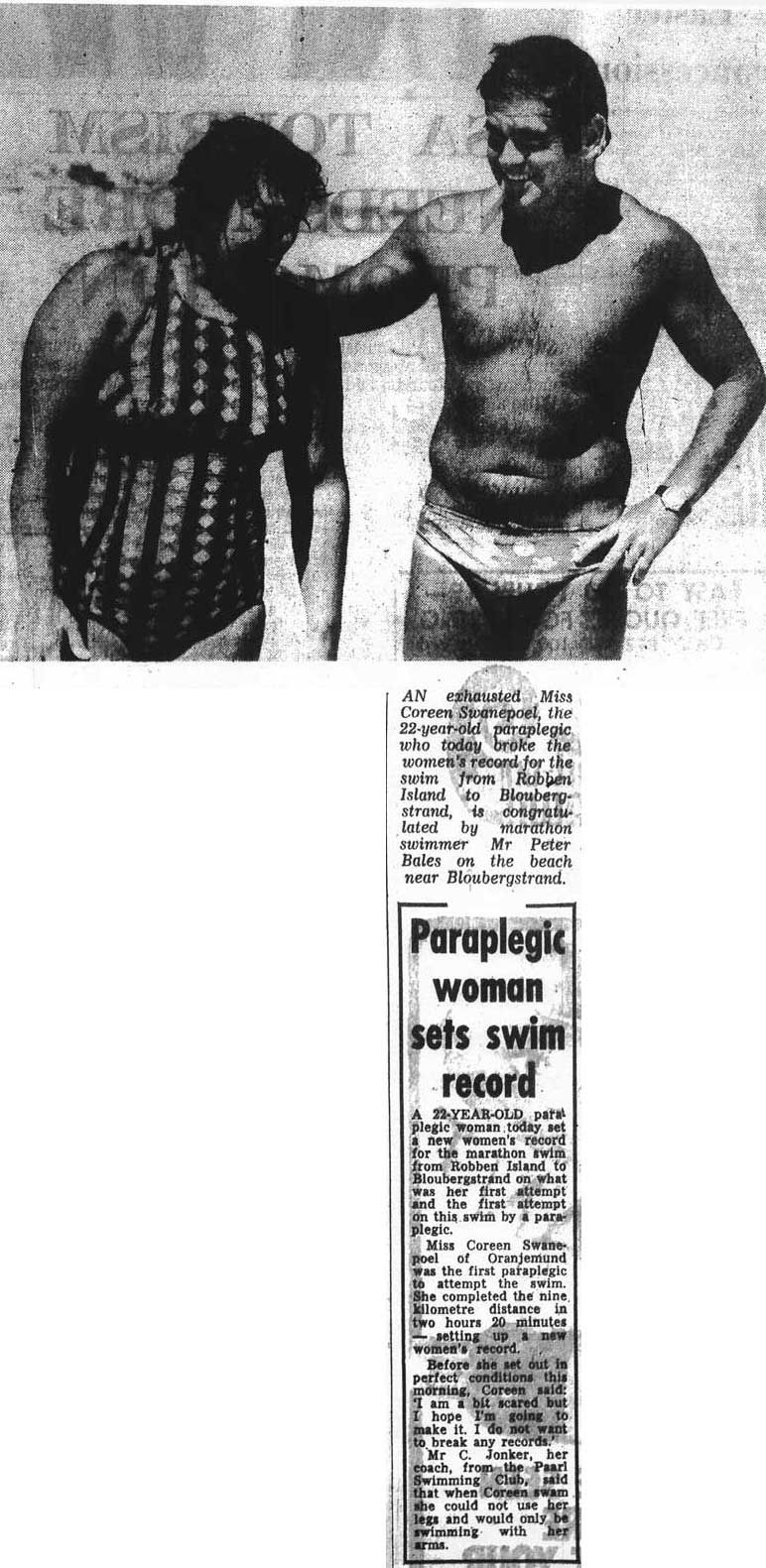
In 2020, Alwyn Uys swam from Robben Island to Bloubergstrand.
(Click here to see a trailer for his movie - Against All Odds: The Alwyn Uys Story.
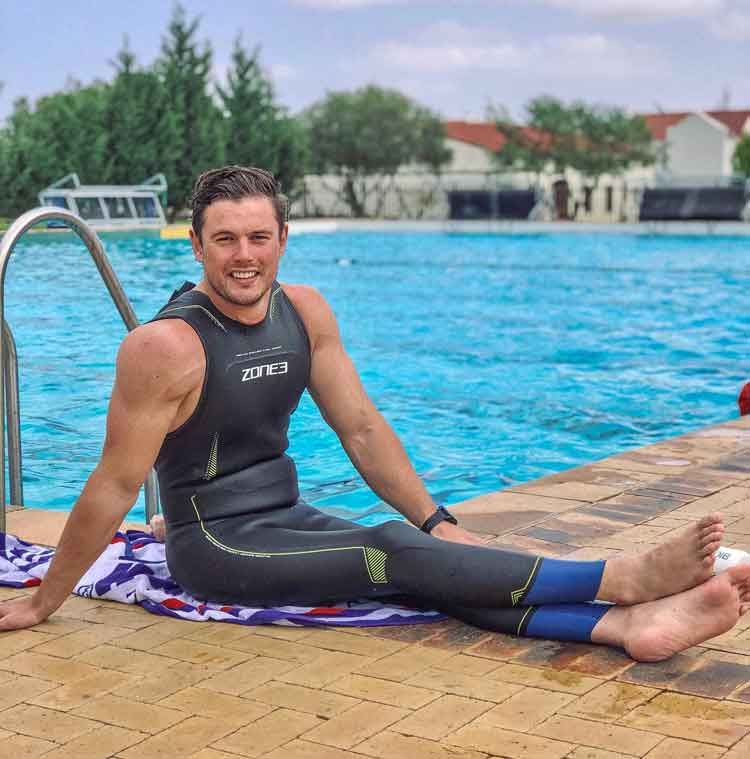
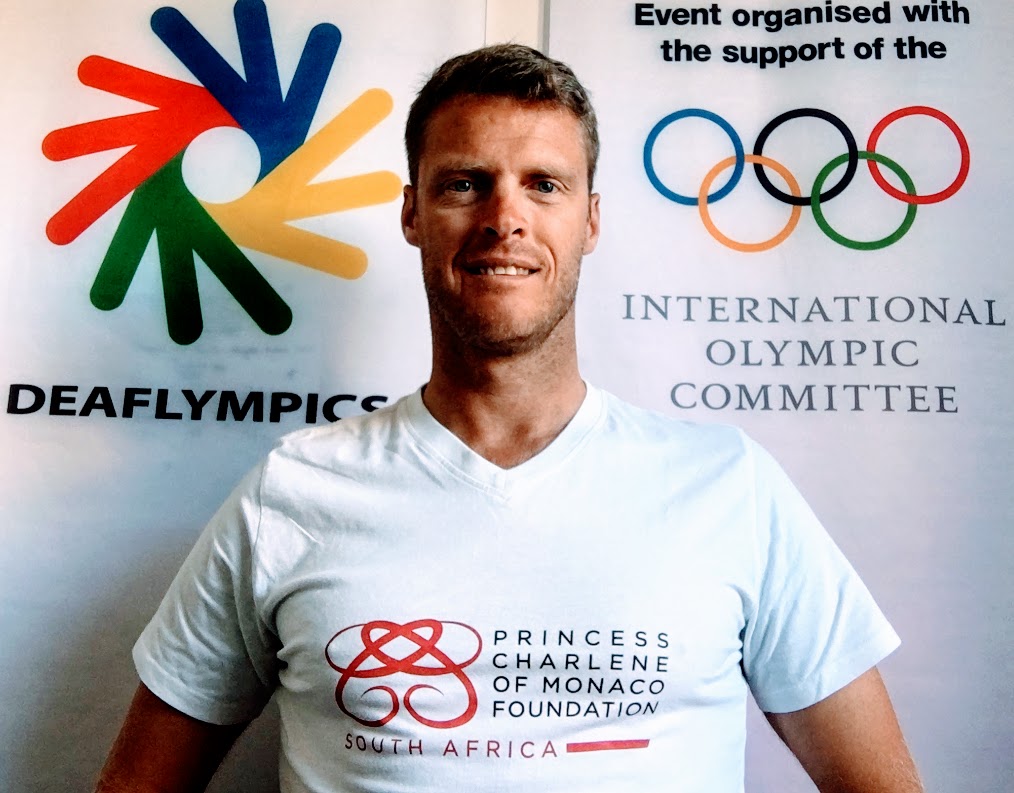
Terence Parkin, a deaf swimmer from South Africa, was born on April 12, 1980, in Bulawayo, Zimbabwe. Over a 15-year sporting career, he competed internationally and professionally for 11 years. Terence’s accomplishments include winning a silver medal at the Sydney Olympics and becoming the most successful sportsman in the history of the Deaflympics since its inception in 1929, with an impressive collection of 29 gold medals, along with one silver and one bronze medal in cycling across 4 Deaflympic Games. He holds an astounding 50 Deaf World Records in both long and short course swimming, earning him the nicknames ‘Silent Torpedo’ and the Michael Phelps of the Deaflympics.
Taking a break from swimming, Terence ventured into triathlons and cycling, winning the World Deaf Cycling Championships’ 120km road race in California in 2005. Locally, he has participated in major events like the Dusi Canoe Marathon, Sani2C, Amashovashova, and the 94.7 Cycle Challenge.
Terence’s accolades include multiple awards such as World Deaf Sportsman of the Year (1997, 2000, 2001, 2005), CISS Sportsman of the Century (2000), SA Schools Sportsman of the Year (2002), and Gold Presidential Awards (2000, 2001, 2002).
His remarkable success is a result of unwavering dedication to training, spending countless hours in the water or on his bike daily. Terence’s relentless pursuit of excellence has set a benchmark for deaf sports globally, inspiring fellow athletes like Roland Schoeman, who marvel at his intense training regimen. In a notable act of heroism, Parkin rescued a young boy from drowning in 2011.
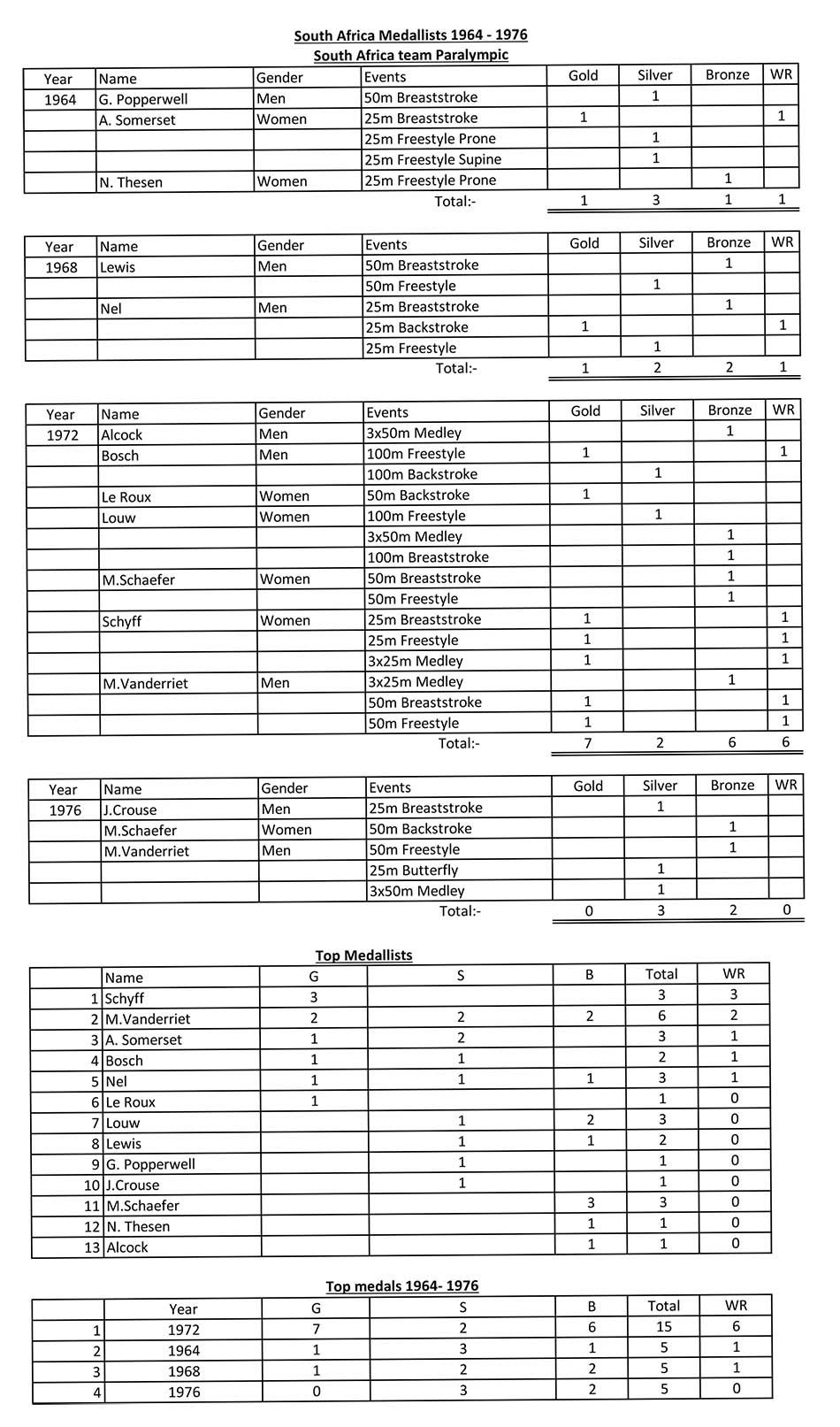
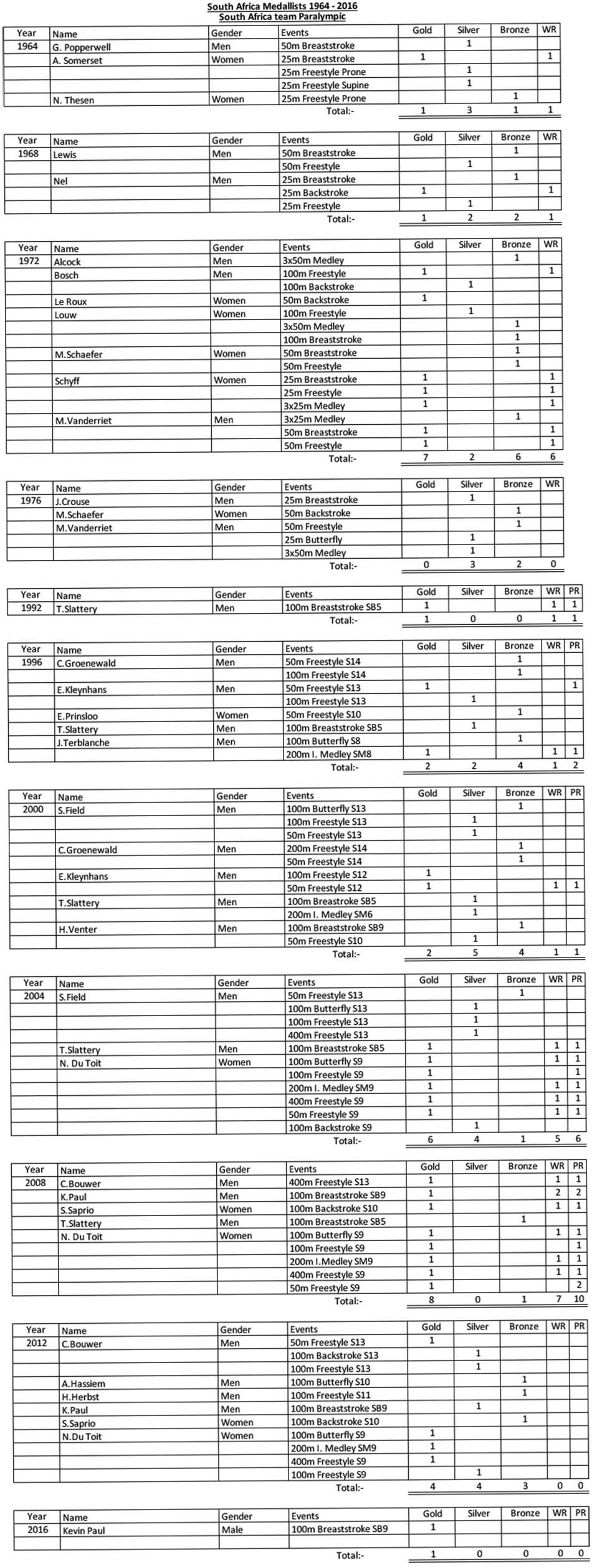

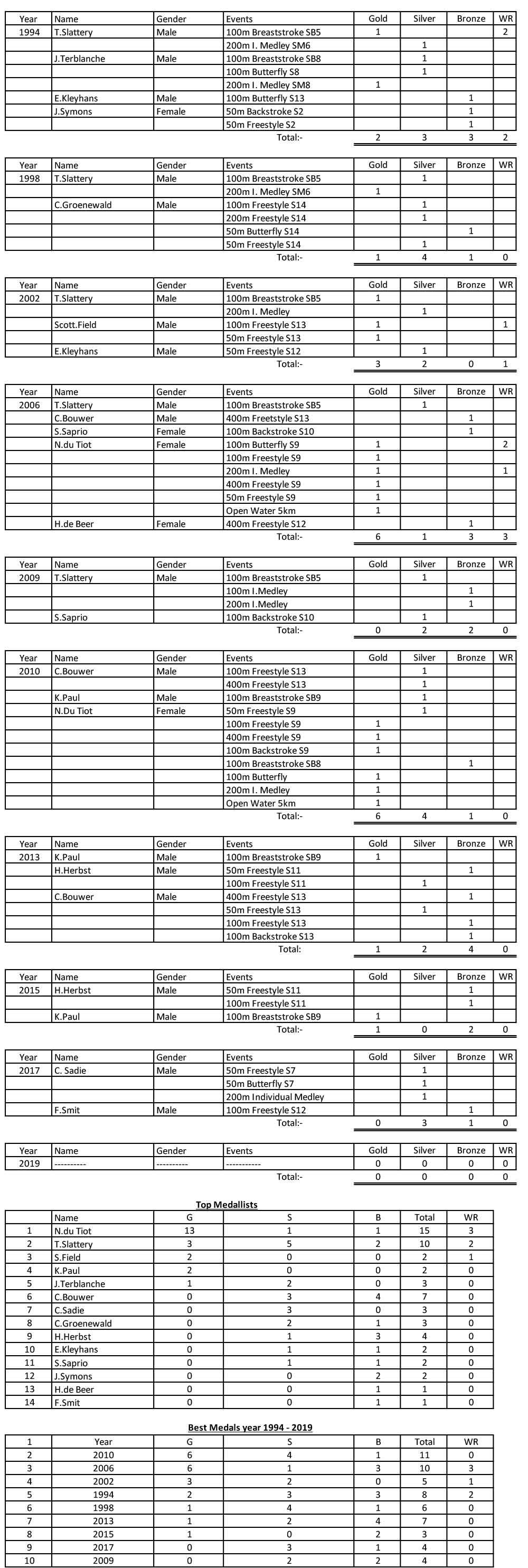
| Rank | Athlete | Games | Gold | Silver | Bronze | Total |
|---|---|---|---|---|---|---|
| 1 | DU TOIT Natalie | 2004-2012 | 13 | 2 | 0 | 15 |
| 2 | SCHYFF | 1972 | 3 | 0 | 0 | 3 |
| 3 | SOMERSET A. | 1964 | 1 | 2 | 0 | 3 |
| 4 | SAPIRO Shireen | 2008-2012 | 1 | 0 | 1 | 2 |
| 5 | LOUW | 1972 | 0 | 1 | 2 | 3 |
| 6 | SCHAEFER M. | 1972-1976 | 0 | 0 | 3 | 3 |
| Rank | Athlete | Games | Gold | Silver | Bronze | Total |
|---|---|---|---|---|---|---|
| 1 | KLEYNHANS Ebert | 1996-2000 | 3 | 1 | 0 | 4 |
| 2 | SLATTERY Tadhg | 1992-2008 | 2 | 3 | 1 | 6 |
| 3 | VANDERRIET M. | 1972-1976 | 2 | 2 | 2 | 6 |
| 4 | BOUWER Charles | 2008-2012 | 2 | 2 | 0 | 4 |
| 5 | PAUL Kevin | 2008-2016 | 2 | 1 | 0 | 3 |
| 6 | NEL | 1968 | 1 | 1 | 1 | 3 |
| 7 | BOSCH | 1972 | 1 | 1 | 0 | 2 |
| 8 | TERBLANCHE J. | 1996 | 1 | 0 | 1 | 2 |
| 9 | FIELD Scott | 2000-2004 | 0 | 5 | 2 | 7 |
| 10 | LEWIS | 1968 | 0 | 1 | 1 | 2 |
| VENTER Hannes | 2000 | 0 | 1 | 1 | 2 | |
| 12 | GROENEWALD Craig | 1996-2000 | 0 | 0 | 4 | 4 |